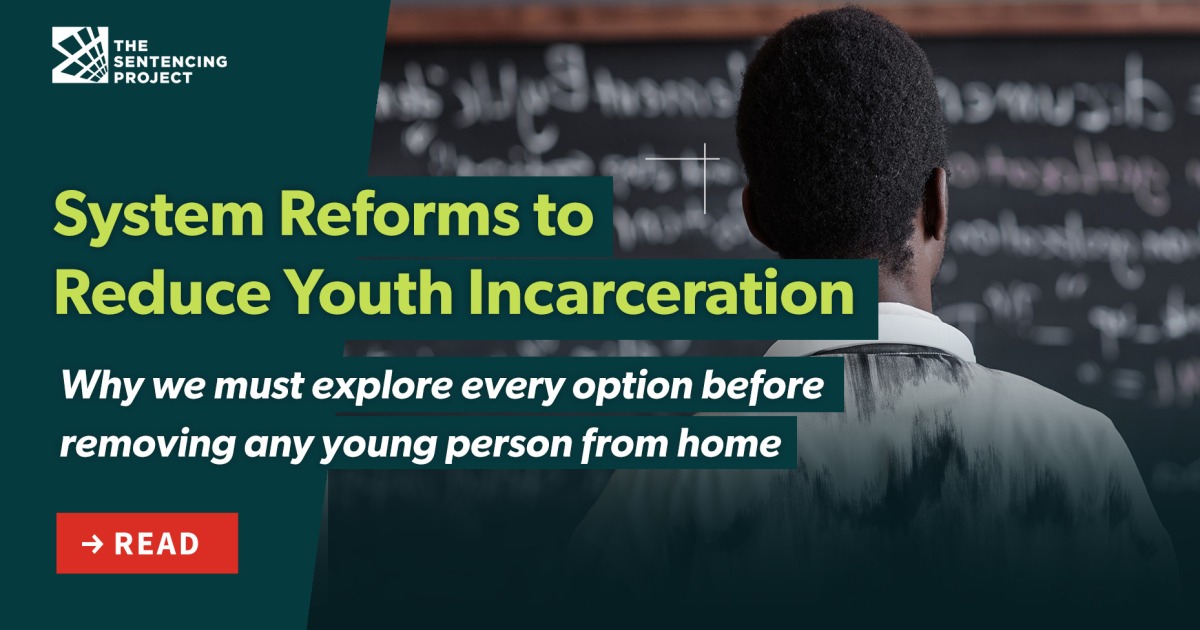
Local Reforms
How local system players manage the cases of youth referred for prosecution or placed on probation, and the mindset they bring to their work, are pivotal in reducing the unnecessary use of incarceration. Too often, youth justice systems employ practices that ignore the lessons of adolescent development research and conflict with the evidence of what works to steer youth away from delinquency. As a result, systems can propel youth – even those without a history of serious offending – down a path toward incarceration.
To correct these problematic practices and minimize overreliance on incarceration, local youth justice systems can emulate innovative jurisdictions that are taking steps to:
- Narrow the pipeline to incarceration by reducing arrests, expanding diversion (in lieu of formal court processing), and reducing use of pretrial detention.
- Transform probation practices to align with adolescent development research and focus on youth success.
- Stop incarcerating youth for violating probation rules and conditions.
- Undertake comprehensive race-conscious system reform aimed at reducing correctional placements.
- Explore every option before removing any young person from home.
1. Narrow the pipeline to incarceration.
Young people’s likelihood of being incarcerated is heavily dependent on decisions made in the early stages of the justice system. Whenever young people are arrested (versus given a warning by police or a civil citation), whenever they are referred on delinquency charges and have their cases formally processed in juvenile court (instead of diverted), and whenever young people are locked in detention pending their court hearings (instead of being allowed to remain at home), their odds of continued involvement in the justice system – and subsequent incarceration – increase substantially.
Overuse of arrests, formal court processing, and detention play a critical role in perpetuating racial and ethnic disparities in incarceration. These early stages of the process have the greatest disparities in the youth justice system, and studies consistently find that these disparities are driven at least partly by biased decision-making.
Therefore, among the most important steps local justice systems can take to reduce overreliance on incarceration – and many systems are taking – include reforms to:
- Avoid arrests for less serious misbehavior at school and in the community: Many studies show that youth who get arrested during adolescence have substantially more involvement in the justice system – and substantially higher dropout rates – than comparable youth who engage in similar misbehaviors but don’t get arrested. Local jurisdictions have taken a variety of steps to reduce arrests.
- In the wake of national protests after George Floyd’s murder, nearly 50 jurisdictions removed law enforcement officers from their schools. Unfortunately, some jurisdictions have reversed course since 2020 and returned law enforcement officers to schools; however, there remains no evidence that stationing officers in schools improves public safety, and considerable evidence that it harms student wellbeing.
- Jurisdictions such as Clayton County, GA, and Philadelphia, PA, have drastically reduced arrests at school after crafting new rules that prohibit arrests at school for a variety of less serious offenses.
- Still other jurisdictions – like Baltimore City, MD – have vastly reduced school arrests after embracing a restorative justice approach to school discipling.
- For misbehavior outside of school, police officers can be empowered to refer youth to pre-arrest diversion programs in lieu of arrest, or to issue civil citations. For instance, Florida police issued civil citations (instead of making arrests) to more than 11,000 youth in 2022, and research shows these youth are far less likely to re-enter the justice system than comparable peers who get arrested for the same offenses.
- Divert from court a substantial majority of referred cases and allow community organizations, rather than courts or probation, to address misbehavior outside the justice system. Powerful new research makes abundantly clear that formally processing youth in juvenile court – criminalizing adolescent misbehavior – results in far worse outcomes: far higher subsequent involvement in the justice system, and worse educational and career success. For the large majority of delinquency cases – other than youth involved in serious offending – diversion from the justice system yields better outcomes both for public safety and youth success. Davidson County (Nashville), TN more than tripled the share of new cases diverted from 2013 to 2020 (from 17% to 54%) and empowered a network of community-based youth development organizations to oversee their cases.
- Minimize the use of locked detention for youth pending their court hearings. Research finds that detention in the pre-trial period substantially increases the likelihood that youth will be placed in a residential facility if found delinquent by a judge; and even short stays in detention reduce educational attainment and increase the likelihood of subsequent involvement in the justice system. Through its Juvenile Detention Alternatives Initiative (JDAI), the Annie E. Casey Foundation has created a comprehensive and effective model for combatting overreliance on detention based on eight core principles. More than 300 jurisdictions nationwide – home to nearly one-third of all US children – adopted the JDAI model, and participating sites reduced average daily detention populations in detention by 50%, with no harm to public safety. An independent evaluation found that jurisdictions participating in JDAI reduced their detention populations five times more than other jurisdictions within their states. Tellingly, participating JDAI sites reduced their commitments to state custody by 63% — even more than they reduced detention admissions.
- Research finds that youth of color are often treated more harshly than white youth at these critical early stages, and disparities tend to be especially large. Therefore, local justice systems should collect and carefully analyze data by race and ethnicity at these early stages, and they should use the data to identify problematic practices that exacerbate disparities and institute reforms that ensure greater equity.
2. Transform probation practices to align with adolescent development research and focus on youth success.
Probation is by far the most common outcome in cases referred to juvenile delinquency courts nationwide. Two-thirds of youth adjudicated delinquent in 2020 (analogous to being found guilty in criminal court; 89,000 youth) were ordered to probation, and nearly as many more were placed on informal probation either as part of a deferred prosecution agreement or consent decree (an additional 44,000 youth) or after their case was diverted from formal court processing (an additional 32,000 youth). Yet voluminous research shows that the traditional approach to juvenile probation, in which courts hand youth a long list of standard rules and conditions and then a probation officer monitors their compliance, has little or no effect on future offending. Many of the most common practices in probation conflict with research and expert opinion on effective interventions to stem delinquent conduct.
For instance, imposing long lists of standard conditions and focusing probation on compliance conflicts with the lessons of adolescent behavior and brain development research. Attempting to coerce behavior change through threats of punishment rather than incentives for positive behavior ignores the evidence showing that teens are unlikely to be swayed by threats of future punishment, but highly responsive to positive incentives. Also, probation agencies too often make critical decisions about young people’s cases without involving their parents and families. Research shows that parents continue to play a pivotal role in their children’s lives, and many of the most effective intervention models for combatting delinquency focus on families. Yet most probation agencies still struggle with, or do not prioritize, family engagement to ensure that families are integrally involved in crafting their children’s case plans and making key decisions.
Since 2018, several leading organizations in the youth justice field—including the Annie E. Casey Foundation, the National Council of Juvenile and Family Court Judges, and the National Center for Juvenile Justice—have called on juvenile courts and probation agencies to reorient probation away from the traditional surveillance-compliance mindset. Specifically, the new best-practice guidance urges youth justice system leaders to:
- Stop ordering all youth on probation to comply with a standard list of probation rules and conditions.
- Shift probation’s focus away from compliance monitoring and toward case planning, brokering helpful services and opportunities in the community, and support for young people’s success.
- Adopt a family-engaged case planning process in which probation officers partner with youth and families to identify goals and activities that will help the young person avoid problem behaviors and achieve long-term success.
- Encourage positive behavior change through incentives and rewards for youth to meet behavior expectations and achieve their case plan goals.
- Connect young people with activities in the community where youth can develop new skills and build relationships with caring adults and positive peers.
- Carefully monitor data measuring probation’s impact on youth by race, ethnicity and gender, and make reducing disparities a clear and explicit goal for probation.
A number of local justice systems around the country are adopting these principles. In 2011 and 2012, New York City’s Department of Probation pioneered the development of the family-engaged case planning model which has subsequently been documented in a practice guide available to jurisdictions nationwide. Pierce County (Tacoma), WA has created an Opportunity-Based Probation model that offers an array of rewards and incentives for youth on probation to achieve the goals of their case plans. Pierce County has also created a network of local community-based organizations that provide positive youth development opportunities for youth on probation. Ohio’s Department of Juvenile Justice has made probation transformation a statewide goal, organized in-depth regional training sessions on probation transformation, and made advancing key elements of probation transformation a requirement for counties in their applications for state juvenile justice funding.
3. Stop incarcerating youth solely for violating probation rules and conditions.
While the case for transforming probation is compelling, even jurisdictions that do not embrace this new paradigm can and should stop incarcerating youth solely for rule-breaking behaviors and non-compliance with probation orders that do not involve new crimes. Research makes clear that this practice is counterproductive for both public safety and youth success, and that it exacerbates racial and ethnic disparities in incarceration. Yet, as the Center for Children’s Law and Policy has explained, “In many jurisdictions, technical violations represent one of the leading reasons for admission to detention or out-of-home placement.” In South Carolina, for instance, the top four offenses among youth committed to state custody in 2019 all involved probation violations. In Maricopa County (Phoenix), AZ, 48% of youth sent to state custody in Fiscal Year 2020 were committed for probation violations. In Maryland, 27% of commitments to state custody in 2013 were the result of probation violations, not new offenses.
In a 2017 resolution, the National Council of Juvenile and Family Court Judges (NCJFCJ) urged juvenile courts nationwide to “ensure that detention or incarceration is never used as a sanction” for youth who violate probation rules. In a new 2022 toolkit on judges’ roles in reforming juvenile probation, NCJFCJ again urged juvenile courts to stop confining youth as a consequence for rule violations, and – noting that youth of color are confined for violations disproportionately – the toolkit stated that “rejecting the use of confinement as a response to probation rule violations… represents one of the single most important and valuable steps that juvenile courts can take to reduce system disparities.”
To reduce the use of incarceration in response to rule violations, Santa Cruz County, CA no longer places youth into correctional or residential treatment facilities as a consequence for rule violations, and it has dramatically reduced the number of youth placed in short-term detention for violations. St. Louis, MO and Lucas County (Toledo), OH have also sharply reduced detention in response to rule violations.
4. Undertake comprehensive race-conscious system reform aimed at reducing correctional placements.
America’s youth justice systems continue to incarcerate youth of color, especially Black youth, at far higher rates than their white peers. In 2020, the last year for which data are available, 41% of youth newly incarcerated nationwide were Black, even though Black youth make up 15% of the total youth population.
From 2012 through 2020, 12 jurisdictions participated in the Annie E. Casey Foundation’s “Deep End Initiative” to reduce out-of-home placements following adjudication, especially for youth of color. As part of the initiative, the sites reviewed all decision points where youth may enter the justice system or penetrate deeper to more serious levels of supervision (arrest, formal processing in court, revocation of diversion for non-compliance, filing of a probation violation, incarceration), as well as mechanisms at each decision point that allow youth to exit the justice system or at least to remain at home (no arrest, diversion from formal processing, placement on probation or another at-home disposition). Sites examined how each stage affected Black youth and other youth of color differently than white youth, and they strategized to address the disparities they uncovered and to reduce the share of youth – especially youth of color – who were propelled at each stage to deeper involvement in the justice system.
The Casey Foundation reported that participating sites reduced the number of new correctional placements by far more than the national average. By 2017, sites that started in 2012 had reduced their correctional placements by 54% (versus a national decline of 25%), and sites that started in 2014 reduced correctional placements by 37% (versus a national decline of 8%). Just as encouraging, correctional placements for the sites fell as much or more for African American youth as for the total youth population. Also, in all nine Deep End sites that provided complete data, the decline in placements for African American youth far outpaced the national average.
While the Casey Foundation’s Deep End Initiative is no longer operating, the tools and techniques employed to achieve these favorable results can be applied by any jurisdiction, at any time. A “Deep End Toolkit” is still available on the Annie E. Casey Foundation’s website.
5. Explore every option before removing any young person from home.
The final step local youth justice systems can take to minimize incarceration comes when a young person commits serious offenses or reoffends repeatedly, and therefore becomes a candidate for placement in a correctional facility or other residential program. Rather than routinely endorsing decisions to remove any young person from home in these circumstances, the National Council of Juvenile and Family Court Judges recommended in 2022 that juvenile courts and probation agencies: “Make it a practice to convene a family-team meeting and/or case staffing for any young person being considered for residential placement, and use these review sessions to explore every available option or alternative to placement.”
Among the jurisdictions that have instituted this practice are Santa Cruz County, CA, Lucas County (Toledo) and Summit County (Akron), Ohio, and Pierce County, WA. Typically, the meetings include system staff, mental health experts, and representatives from child-serving organizations in the community – and often the young person, his or her family, and other important figures in the child’s life. The NCJFCJ toolkit urged that: “All parties participating in these meetings should generate ideas together seeking to answer the question: what will it take to keep this young person at home under probation safely?”
This post was originally published on this site be sure to check out more of their content.







